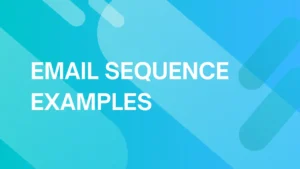
Domain Age: What Is It and Why Is It Important?
“Domain age” refers to how long a given domain has been in use.
What Is Email Domain Age?
“Domain age” refers to how long a given domain has been in use. For example, a domain aged ten years in 2021 would have been initially activated in 2011.
Search engines account for how long a domain has been in use as well as how long the website attached to the domain has been active.
When a search engine user types in a particular keyword, the search engine tends to favor websites that have been active longer because these websites have built a credible reputation and will rank them higher on the results page.
Tip: If you would like to learn more about SEO keywords, or keyword finder tools, make sure to check out this comprehensive SEO guide.
In the eyes of a search engine, an older website with an established domain shows more credibility than a newly established website with a brand new domain.
Since domain age is one of the first things spam filters look at, it impacts email deliverability because domains with a better reputation are more likely to get into new inboxes.
It’s easier for established domains with a positive reputation to have successful cold email campaigns.
However, it’s also crucial to understand that domain age on its own will not be the deciding factor of whether your messages make it to your recipients.
And it definitely doesn’t guarantee that they’ll open the message.
Maintaining positive interactions with as many users as possible and keeping a positive sender reputation is essential for a cold email campaign.
You could have a twenty-year-old domain, but your messages will end up in the spam folder if that domain has a bad reputation.
Why Is Email Domain Age Important?
In short, domain age is important because it’s one of the multiple factors that impact your cold email deliverability rate.
Having a high cold email deliverability rate means that you’ll have a better chance of converting your leads and building brand awareness.
The primary goal of any email campaign is to send emails to people who will see your email, open it, follow a link to your website, and buy something.
The best way to increase the chances of this happening is to have the ability to get your emails directly into your recipients’ inboxes rather than the spam folder or promotions folder.
An older domain with a stellar reputation allows you to send cold emails that nurture leads.
As opposed to social media posts, cold emails are more effective because they will wait in a customer’s inbox until the recipient is ready to click on it.
They might not open your message right away, but if they see that they got an email from you, your business will be fresh on their mind as they continue with their day.
Unless people are waiting for a specific email from someone, they don’t sift through their spam folder.
Having an older domain with a positive reputation increases the likelihood that not only will your email be delivered, but it will also go to their inbox, where they’re more likely to see it and interact with it.
With a warm, established domain, you can also use cold emails to increase brand awareness.
Mass email campaigns are infinitely more effective than cold calls or door-to-door sales because you can reach a greater number of people with a single click of a button.
However, this can be tricky because you don’t want to have your address mistaken for spam and placed on a blocklist.
As long as you maintain a good sender reputation, you should have no problem broadening your audience.
And the good news is we can help with that.
You can even automate the cold emails you send to make things that much easier for your team.
This allows you to analyze which aspects of the emails are working and what needs work.
Analytics will tell you whether your emails are getting delivered, how many are being opened, and your click-through rate.
You can create stronger emails that have a better engagement rate as your domain gets older and more trustworthy in the eyes of servers.
How Is Domain Reputation Calculated?
The domain reputation differs from your IP reputation because multiple people can share an IP address while your domain belongs explicitly to you.
You can change your IP address easily, but changing your domain is much more complicated, so it’s essential to have a positive domain reputation.
Your domain’s reputation is like a credit score from your email and is measured on a scale of 0-`100, with 100 being a perfect score.
There are myriad factors that influence your domain’s reputation, including:
- Number of Messages Automatically Processed as Spam
- Read Rate
- Number of Messages Deleted Before Opening
- Open Rate
- Click-Through Rate
- Reply Rate
- Forward Rate
- Spam Complaint Rate
- Number of Messages Marked as “Not Spam” by the Recipient
- Hard Bounces
- Number of Messages that Fall into Spam Traps
Does the Domain Age Matter for Email Deliverability?
The short answer is yes, domain age matters for email deliverability.
But there is a bit more to it than that.
The main job of ESPs and ISPs is to protect their users from spam and malicious content.
When these servers receive messages from a sender they’ve never seen before, they run the domain through multiple checks.
One of these checks is the age of the domain.
But why does domain age matter in the first place?
Cybercriminals have adopted the practice of registering a new domain and sending out as many spam emails as possible before the domain is blocklisted or shut down.
Because of this technique, spam filters and servers are wary of brand new domains trying to send their recipients messages.
This is why it’s commonly assumed that the older a domain is, the more trustworthy it will be, and the more likely it is that servers will let their messages through.
But if you have an older domain with a mediocre or bad reputation, you won’t be able to get into your recipients’ inboxes.
It’s critical to check the domain’s reputation before beginning a cold email campaign instead of relying on a domain’s age to carry the message straight to the intended inbox.
If you’re using an older domain with a spam or bounce rate above 5%, you’re better off registering a new domain, warming it up, and then beginning the campaign once the domain is warm.
Nurturing a new domain allows you to increase the age while bolstering the reputation organically.
This increases the chance that you’ll be able to get your emails into your consumers’ inboxes instead of the spam folder.
How to Check Email Domain Age
If you already know when your domain was registered, then you’ll have an easier time determining the domain age.
But if you don’t have a record of when your domain was activated, you can use a domain age checker.
There are multiple online applications, but be sure to use a reputable checker such as who.is or Cisco Talos.
You’ll begin by copying and pasting the domain you’d like to view, usually be your website name.
We used our website to demonstrate how this works.

When we run the search on who.is, we get a results page that details all the public information about our domain.
Under “Important Dates,” it shows that our domain was registered on June 25, 2020.
So, our domain age is a little over a year.

And that’s it!
On Talos, you have to use the “WHOIS” tab to find the creation date, but the application will provide more details about the domain’s reputation, email volume, and more.




